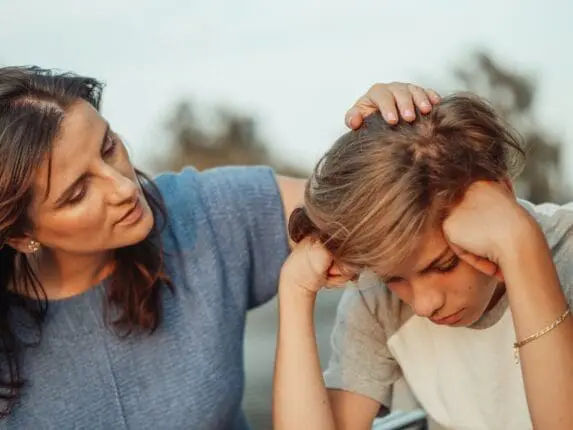To the therapists working with families who witnessed the Highland Park parade shooting on July 4th, or to any family that has witnessed gun violence, my heart goes out to you. I recently went to a Highland Park school to provide emotional first aid to affected families. I was ushered into a teacher break room, where I saw over a dozen anxious therapists looking back at me. There were donuts, coffee, bagels, and fruit. It reminded me of a shiva, the Jewish house of mourning where mourners and guests sit and wait for the initial shock and pain to subside. Every few minutes, a first-grade teacher, who was in charge of triage, would come into the room and announce, “I have a mom who wants help talking to her children about what happened,” or “I have a group of three 12-year-olds who were at the parade who want to talk.”
At each announcement, we therapists looked at each other, as if to ask, “Am I capable of doing this?” When one therapist stood up with her bag of art supplies, she turned over her shoulder, looked at me, and said, “Wish me luck.”
“Good luck,” I responded, but I wish I’d responded with the French saying “bon courage,” which, translated literally, means “good courage.”
For therapists who are helping parents process their pain after a school shooting, here are some guidelines. I’ve developed after working with these parents myself.
Create Awareness
The first step is to help the parent struggling with the shooting develop awareness of their own behavior in the aftermath of the event. How adults like parents and teachers react is a critical determinant of how the children around them will feel, articulate their feelings, and behave. Children can read parental anxiety and stress like it’s being shown on 100-inch TV screen.
Are the parents talking nonstop about the shooting with friends on the phone in a heightened state of emotion, watching 24-hour news coverage, or discussing possible motives for the shooting? If they’re distraught, it’s best to have other adults such as trusted family members and friends in the house who can help care for children. Parents can then find a quiet space in the house to take breaks and process the tragedy, away from where children can see them.
Avoid Judging Reactions
Second, it’s important for therapists to keep in mind, and impart to clients, that there’s no “right” or “healthy” way to react to senseless tragedy. After a school shooting occurs, one child might feel scared to go anywhere for weeks, while another says, “The shooter would never get me, I’m a fast runner.” Remind parents that both types of responses are normal and need to be validated.
Kids react to school shootings differently, from acting spacy and lethargic to hyperactive or irritable. These behavior changes are understandable and should be expected. Depending on the situation, parents might consider temporarily loosening certain house rules or foregoing punishments to make space for this new behavior, particularly if it’s uncharacteristic of the child. That said, if a child is responding in a way that’s harmful to self or others, refer the parent to their pediatrician or a mental health clinician who specializes in this.
Not all kids act out after traumatic events like school shootings. While acting-out behavior is easier to spot, other kids “act in,” withdrawing and internalizing their feelings. Parents need to be on the lookout for these signs as well. Perhaps the child is no longer interested in sports or activities they once loved, or they seem quieter than usual. Again, behaviors such as these signal that the child may need a therapeutic treatment plan.
Age-Specific Interventions
The best intervention with a child struggling in the aftermath of a school shooting is also age-dependent.
After showing initial reactions of shock, disorientation, or crying, children between ages 2 and 5 often try to distract themselves with play or other regular activities, as though they’re no longer affected. Understand that the child may be terrified on the inside, and kids need their parents or a loving adult close by to provide emotional support. Therapists should guide parents to hold their child’s hand, stroke their hair, put a hand on their back, give them extra hugs and cuddles, read them more books, or offer extended bathtime.
Children who are a little older, between the ages of 6 and 10, might be thinking of existential questions but may not know how to express them. In addition to making many of the same suggestions above, therapists should tell parents that it’s okay for both the parent and the child to ask curiosity questions. Parents can say something to their kids like, “When something scary happens, our brains don’t know how to handle it, so it starts asking some weird questions. Do you want to know some weird questions a brain might ask?”
If the child says yes, they can continue by saying, “A brain might ask: ‘Is what happened my fault?’ or ‘Is there something wrong with me because I don’t feel scared, sad, or angry but everyone else does?’ or ‘Is it ever safe to go to a parade (or to the beach or the park) again?’”
If any of these questions resonate with the child, parents should give an answer that’s truthful, accurate, and tailored to the child’s developmental level. If you are doing this in a session, encourage parents to keep their answers short and free of sugar-coating. An appropriate response might be: “I don’t know, but I will do everything in my power to keep you safe.”
Parents might then ask the child what they think the answer to their own question is. This is how children will express their fears, so parents shouldn’t minimize their response. One 12-year-old I spoke with was supposed to be at the parade but overslept. When she told her mom that she should’ve been there to help her friend, her mom instinctively responded that it was good that she wasn’t there. But that’s how the brain copes: we rehearse what we would’ve done to deal with feeling helpless, and we feel guilty that we escaped and someone we love did not. The parent simply listening and acknowledging that the child’s answer is a possibility—and that they will get through this together—is the best way to go.
Pre-teens and adolescents may have a confusing mix of reactions, but they can be resistant to openly talking about them with their parents. A natural inclination could be to pull their teens close, hug them, and reassure them, but teens might reject such overtures. Reassure parents that their teens are thinking about the situation and that they’re more sophisticated and nuanced in their understanding than parents think. I advise parents to invite their teenage children into a conversation as equals, rather than leading with explaining or protecting. For example, a parent might say, “I was thinking about what I would’ve done if I’d been right there, and I don’t know.” If the parent was in the vicinity of the event or in harm’s way, they could say, “It’s so scary to feel the randomness of it all, and I feel lost.”
Repair and Reset Exercises
No matter the child’s age, parents can remind their children that experiencing a mass shooting is not unlike breaking a limb or catching a virus: the body needs time to heal. It needs reduced stress and pressure, along with time spent together with loved ones. It’s common for children to feel both okay and not okay and feel like they want to cry or hide. The important thing is to let children know that this is their body’s reaction, and that, as uncomfortable as it may feel, there’s nothing wrong with them.
During this period of the immediate aftermath and reverberations of the event, which could be two to five weeks, children should be given the leeway to choose whether they want to participate in previously scheduled events like camp or outings with friends. They may need to stay at home more or be with a parent to reestablish a sense of safety.
For children showing acute symptoms of anxiety, stress, and panic, I advise that therapists work with parents to help give their children freedom to express their fears, during select times, for a period of five to seven minutes—more if the child is older. Then, they can do “sensory resets,” helping the child have sensory experiences that reorient their brain’s focus on the anxiety to a feeling in the body. Some examples of this you can share with parents are:
- Having the child drink or eat something cold, like a popsicle
- Having them smell something, like using a fragrant lotion
- Creating movement by by blowing up a balloon and bopping it back and forth
- Listening to music or reading a story
- Going out in nature together and digging in the dirt or feeling the grass under their feet
Final Thought
As I reflect on the heartbreaking fear and pain that I witnessed, I also am moved beyond words to see the resilience of the children and the community. I am left bewildered at how our country and lawmakers enable this type of senseless violence, but also inspired that there were so many helpers on the scene. I only saw a sliver of this and I have been indelibly changed.
At night I think about how this horror has marked these families and community. They are forever changed, and they will spend the rest of their lives trying to make sense of and respond to the day that was once just the 4th of July.
Dafna Lender
Dafna Lender, LCSW, is an international trainer and supervisor for practitioners who work with children and families. She is a certified trainer and supervisor/consultant in both Theraplay and Dyadic Developmental Psychotherapy (DDP). Dafna’s expertise is drawn from 25 years of working with families with attachment in many settings: at-risk after school programs, therapeutic foster care, in-home crisis stabilization, residential care and private practice. Dafna’s style, whether as a therapist or teacher, is combining the light-hearted with the profound by bringing a playful, intense and passionate presence to every encounter. Dafna is the co-author of Theraplay: The Practitioner’s Guide (2020). She teaches and supervises clinicians in 15 countries in 3 languages: English, Hebrew and French. Visit her website.












